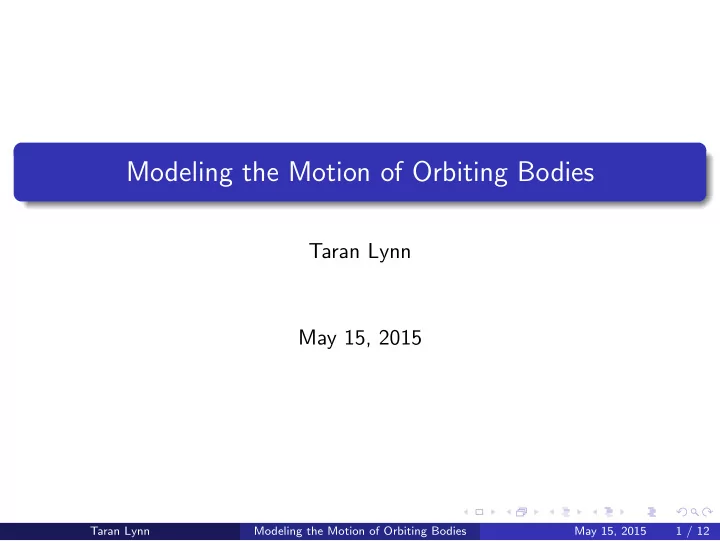

Modeling the Motion of Orbiting Bodies Taran Lynn May 15, 2015 Taran Lynn Modeling the Motion of Orbiting Bodies May 15, 2015 1 / 12
Objective The objective of this project is to model the position of an orbiting object as a function of time. This is achieved by using Newton’s law of universal gravitation and his third law of motion to find a second order ODE that models the relationship between position and time. I will also use Kepler’s laws to find initial conditions for the Newtonian model. Taran Lynn Modeling the Motion of Orbiting Bodies May 15, 2015 2 / 12
Newtonian Model Force on Orbited Object d # « r F g = Gm s m p d t # « r P r | 3 | # « # « r Force on Orbiting Object d 2 # « r F g d 2 # r « d t 2 m p d t 2 S Newton’s Third Law d 2 # « Figure: Orbiting Body Diagram r m p d t 2 = − F g d 2 # « d t 2 = − Gm s m p r # « m p r r | 3 | # « d 2 # « d t 2 = − Gm s r r | 3 # « r | # « Taran Lynn Modeling the Motion of Orbiting Bodies May 15, 2015 3 / 12
Multiple First Order ODEs We can split the second order vector ODE r = − Gm s ¨ # « r | 3 # « r | # « into four first order scalar ODE’s. x = v x ˙ (1) Gm s x v x = − ˙ (2) ( x 2 + y 2 ) 3 / 2 y = v y ˙ (3) Gm s y v y = − ˙ (4) ( x 2 + y 2 ) 3 / 2 Taran Lynn Modeling the Motion of Orbiting Bodies May 15, 2015 4 / 12
Example: Halleys Comet I 1 The mass of the sun is 1 . 99 × 10 30 kg . 2 The comet’s distance from the sun at its perihelion is 8 . 78 × 10 10 m . 3 Its speed at the perihelion is 5 . 46 × 10 4 m / s . y ( m ) 5 × 10 11 x ( m ) Sun - 6 × 10 12 - 5 × 10 12 - 4 × 10 12 - 3 × 10 12 - 2 × 10 12 - 1 × 10 12 - 5 × 10 11 Figure: Halley’s Comet’s Path Taran Lynn Modeling the Motion of Orbiting Bodies May 15, 2015 5 / 12
Example: Halleys Comet II Comet Position 1 × 10 12 1 × 10 10 t ( s ) 2 × 10 9 4 × 10 9 6 × 10 9 8 × 10 9 - 1 × 10 12 x ( m ) - 2 × 10 12 y ( m ) - 3 × 10 12 - 4 × 10 12 - 5 × 10 12 - 6 × 10 12 Figure: Halley’s Comet’s x and y Positions as a Function of Time Taran Lynn Modeling the Motion of Orbiting Bodies May 15, 2015 6 / 12
Example: Halleys Comet III Comet Velocity 5000 v x ( m / s ) 1 × 10 10 t ( s ) v y ( m / s ) 2 × 10 9 4 × 10 9 6 × 10 9 8 × 10 9 - 5000 Figure: Halley’s Comet’s x and y Velocities as a Function of Time Taran Lynn Modeling the Motion of Orbiting Bodies May 15, 2015 7 / 12
Example: Halleys Comet IV v ( m / s ) 15000 10000 5000 1 × 10 10 t ( s ) 2 × 10 9 4 × 10 9 6 × 10 9 8 × 10 9 Figure: Halley’s Comet’s Speed Taran Lynn Modeling the Motion of Orbiting Bodies May 15, 2015 8 / 12
Initial Conditions # r (0) can be calculated using parallax. « The mass of the orbited object can be found by sending a satellite into circular orbit around the orbiting body and using the equation M = 4 π 2 r 3 GT 2 . (5) Taran Lynn Modeling the Motion of Orbiting Bodies May 15, 2015 9 / 12
Initial Conditions: Velocity The velocity of the orbiting object can be found using the vis-viva equation � 2 r − 1 � v 2 = GM . (6) a v P r S Figure: Path of an Orbiting Body Taran Lynn Modeling the Motion of Orbiting Bodies May 15, 2015 10 / 12
Bibliography I Eugene Butikov. Relative motion of orbiting bodies . research. St. Petersburg State University, St. Petersburg, Russia, n.d. Emily Davis. “Deriving Kepler’s Laws of Planetary Motion”. Presentation Slide. Kyriacos Papadatos. “The Equations of Planetary Motion and Their Solution”. In: The General Science Journal (n.d.). Office of Public Information. Comet Halley Summary . N.A.S.A. url : http://er.jsc.nasa.gov/seh/halley.html . Reymond Serway and John Jewett Jr. Physics for Scientists and Engineers with Modern Physics . Ninth. Brooks/Cole, 2014. David Surowski. Kepler’s Laws of Planetary Motion and Newton’s Law of Universal Gravitation . Retrieved from Surowski’s website. Taran Lynn Modeling the Motion of Orbiting Bodies May 15, 2015 11 / 12
Bibliography II Wikipedia. Wikipedia, The Free Encyclopedia . 2015. url : http://en.wikipedia.org/ . Taran Lynn Modeling the Motion of Orbiting Bodies May 15, 2015 12 / 12
Recommend
More recommend